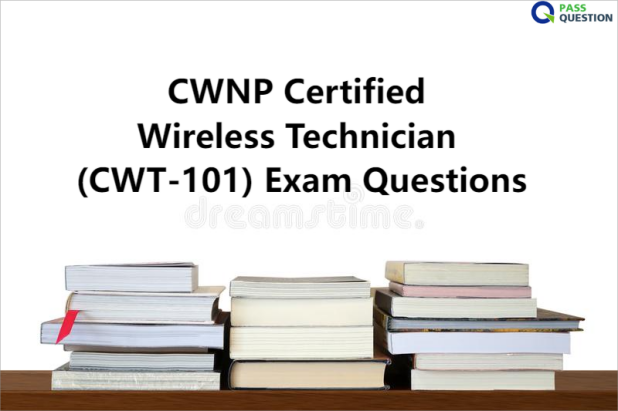CWNP Certified Wireless Technician (CWT-101) Exam Questions
The Certified Wireless Technician (CWT) certification is a comprehensive, beginner-level WLAN certification. To prepare for the CWT-101 exam, the latest CWNP Certified Wireless Technician (CWT-101) Exam Questions, available from PassQuestion, are a valuable resource. They provide an in-depth study guide that will enhance your knowledge, strengthen your understanding of key concepts, and equip you with the necessary skills for the exam. The CWNP Certified Wireless Technician (CWT-101) Exam Questions PassQuestion offers are regularly updated. This ensures that the questions are always in sync with the current exam syllabus, covering all the areas you need to master. Choosing PassQuestion as your study aid for the CWT-101 exam preparation will give you access to high-quality study materials and imbue you with the confidence needed to succeed.

Certified Wireless Technician (CWT)
The Certified Wireless Technician (CWT) is an individual who can install APs based on a design document, configure the AP for initial operations and ensure connectivity. The individual can troubleshoot basic problems and assist users in-person or through remote communications in problem resolution. The ability to configure a WLAN client for connectivity is paramount with an understanding of the configuration process for SSIDs, security settings and other client adapter settings.
This individual is not responsible for WLAN design, analysis or security design; however, the CWT should be able to gather information from a design specification document to properly configure an AP and troubleshoot individual connection issues. The CWT may not be aware of the actual WLAN architectural design, the RF design or the full feature set in use to implement the WLAN.
Becoming a CWT:
The CWT certification is an entry-level WLAN certification from the vendor-neutral CWNP organization that brought you CWNA and other advanced certifications. To earn the CWT certification, you must pass an online exam with a score of 70% or higher. Those desiring to work as instructors teaching CWT classes must pass with a score of 80% or higher. Regardless of the way you choose to prepare for the CWT exam, you should start with the exam objectives, which cover the full list of knowledge tested on the exam. The CWT is a three-year certification, and it is renewed by passing the most recent version of the CWT exam again.
CWT Exam Summary:
Exam Number: CWT-101
Cost: $174.99
Availability: Online Exam
Duration: 90 minutes
Questions: 60 multiple choice/single answer
Language: English
Knowledge Domains of the CWT Exam:
Basic RF Characteristics 15%
- 1.1 Describe RF signal characteristics
- 1.2 Explain RF behaviors and signal propagation
- 1.3 Understand how to detect RF signal factors
- 1.4 Understand basic RF channel plans
- 1.5 Describe the basic differences among antenna types
- 1.6 Use the appropriate external antenna when required
Wireless Device Features and Capabilities 25%
- 2.1 Describe device types and varying capabilities
- 2.2 Explain the basic WLAN location processes for 802.11 wireless networks
- 2.3 Describe the basic steps required in the WLAN connection process for 802.11 wireless networks
- 2.4 Determine the RF features supported by client and IoT devices
- 2.5 Configure client and IoT devices
Wireless Protocol Features and Capabilities 25%
- 3.1 Identify 802.11 AP features and capabilities and understand configuration options related to them
- 3.2 Use appropriate 802.11 AP mounting kits for a specified installation location
- 3.3 Ensure proper PoE provisioning for 802.11 APs and other wireless devices, when required
- 3.4 Ensure IoT devices support the appropriate protocols and configuration
Configuration of Security Parameters 15%
- 4.1 Understand the basics of 802.11 standard security solutions
- 4.2 Identify legacy security technologies that should not be used
- 4.3 Understand the basic security options available for common wireless IoT protocols
Troubleshooting Common Wireless Connection Issues 20%
- 5.1 Troubleshoot connectivity problems
- 5.2 Troubleshoot performance problems
- 5.3 Troubleshoot security problems
- 5.4 Troubleshoot mobility problems
View Online CWNP Certified Wireless Technician CWT-101 Free Questions
1. What kind of authentication is used by WPA2-Enterprise implementations?
A. WEP
B. Preshared key
C. Passphrase
D. 802.1X/EAP
Answer: D
2. What are some common causes of mobility problems in wireless networks?
A. Configuration errors
B. Improper network settings
C. Unsupported fast roaming methods
D. Non-implemented roaming features
Answer: A
3. What do antenna pattern charts represent?
A. Available channels by protocol
B. Co-Channel Interference (CCI) and Co-Channel Contention (CCC)
C. Antenna patterns and signal coverage areas
D. Regulatory constraints on channel selection
Answer: C
4. Which feature of an 802.11 AP determines the supported wireless frequency bands?
A. PHY and frequency band support
B. Single-band vs. dual-band
C. Output power control
D. Operational modes
Answer: A
5. What are the basic steps involved in the WLAN connection process for 802.11 wireless networks?
A. Authentication, Association, 802.1X/EAP authentication
B. Passive scanning, Active scanning, 4-way handshake
C. Authentication, Association, 4-way handshake
D. Passive scanning, Active scanning, 802.1X/EAP authentication
Answer: C
6. What does output power control allow you to do in the configuration of an AP?
A. Increase or reduce the output power
B. Change the channel
C. Implement Dynamic Frequency Selection (DFS)
D. Increase or reduce the antenna gain
Answer: D
7. Which factor can negatively impact wireless signal strength and cause connectivity issues?
A. Configuration errors
B. Interference
C. Supplicant issues
D. Co-channel interference (CCI)
Answer: B
8. Which factor can contribute to low data rates in a wireless network?
A. Interference
B. Co-channel interference (CCI)
C. Configuration errors
D. Low signal strength
Answer: D
9. Which configuration option allows control over the transmit power of an 802.11 AP?
A. PHY and frequency band support
B. Single-band vs. dual-band
C. Output power control
D. Operational modes
Answer: C
10. Which feature of an 802.11 AP allows the use of internal and external antennas?
A. Output power control
B. Operational modes
C. Multiple-SSID support
D. Antenna support
Answer: D
- TOP 50 Exam Questions
-
Exam
All copyrights reserved 2025 PassQuestion NETWORK CO.,LIMITED. All Rights Reserved.

